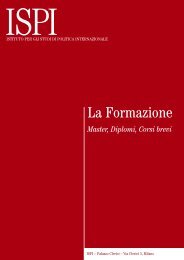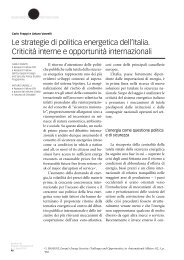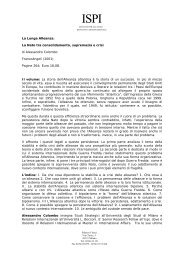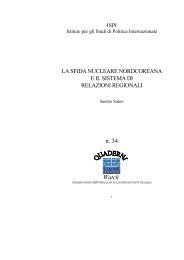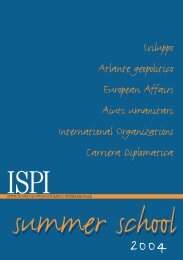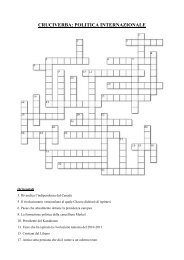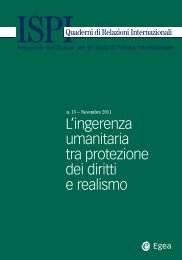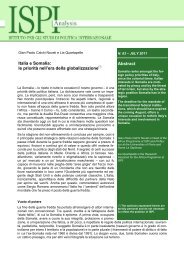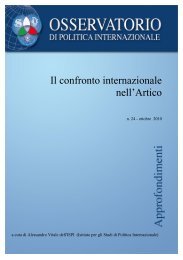heightened sectarianism in the middle east: causes, dynamics ... - Ispi
heightened sectarianism in the middle east: causes, dynamics ... - Ispi
heightened sectarianism in the middle east: causes, dynamics ... - Ispi
You also want an ePaper? Increase the reach of your titles
YUMPU automatically turns print PDFs into web optimized ePapers that Google loves.
©ISPI2013Islam was re-<strong>in</strong>troduced as an identity and political ideologyadaptable to <strong>the</strong> social contexts of <strong>in</strong>complete modernization. It wasredef<strong>in</strong>ed through new ideological read<strong>in</strong>gs that sought to conciliate –or compromise – between tradition and modernity. The new Islamismis not a return to <strong>the</strong> past; it is <strong>the</strong> return of <strong>the</strong> past to serve <strong>the</strong> present’sconditions. It is an identity that compensates for <strong>the</strong> dismantledtraditional structures and, at <strong>the</strong> same time, provides a worldviewabout <strong>the</strong> state, <strong>the</strong> just government and cultural affiliation with morepoliticized societies.With <strong>the</strong> rise of political Islamism, <strong>sectarianism</strong> ga<strong>in</strong>ed more prom<strong>in</strong>enceand it was accompanied by <strong>the</strong> reconstruction of collective narrativesable to serve today’s conflicts. Sectarianization was <strong>the</strong> lateststage <strong>in</strong> <strong>the</strong> broader process of Islamization. While early versions of <strong>the</strong>new Islamism tried to present a trans-sectarian vision, socio cultural,geopolitical and ideological differences gradually reemphasized <strong>the</strong>Sunni-Shi’a schism. This transformation has been triggered by<strong>the</strong> rivalry among Islamist groups and <strong>in</strong>stitutions to ga<strong>in</strong> constituencysupport, hence encourag<strong>in</strong>g a shift towards identity politics.Accord<strong>in</strong>gly, differences between Sunnism and Shiism <strong>in</strong> religiousculture, doctr<strong>in</strong>es, <strong>in</strong>tuitions and conceptions of state-society relations,were <strong>in</strong>creas<strong>in</strong>gly underl<strong>in</strong>ed.In addition, <strong>the</strong> grow<strong>in</strong>g obsession with identity, which is typical ofspheres where official nationalism is fail<strong>in</strong>g to represent all socialsectors, contributed to <strong>the</strong> emergence of sectarian groups as new socio-culturalconstructs that represent an ‘imag<strong>in</strong>able community’.Sectarianism managed to revive <strong>the</strong> notion of ‘community’ <strong>in</strong> contextswhere <strong>the</strong> state is ei<strong>the</strong>r very weak or perceived as <strong>the</strong> enemy. Thiscommunal identity is open even to those who are not religious or Islamist.For example, <strong>the</strong> alliance which l<strong>in</strong>ks <strong>the</strong> Iranian regime,Hizbullah and <strong>the</strong> ‘secular’ Syrian regime represents a sectariantransnational identity. Similarly, it is <strong>the</strong> ‘Sunni’ identity ra<strong>the</strong>r thanany ‘Islamic doctr<strong>in</strong>e’ that brought Syrian rebels, Saudi Arabia, Qatarand Turkey toge<strong>the</strong>r <strong>in</strong> one camp dur<strong>in</strong>g <strong>the</strong> Syrian civil war.When and where <strong>the</strong> sectarian identity is not <strong>the</strong> ma<strong>in</strong> politicalframe, political and ideological differences become more prom<strong>in</strong>ent(as was <strong>the</strong> case <strong>in</strong> <strong>the</strong> rivalry between Saudi Arabia and both Qatarand Turkey <strong>in</strong> Egypt).Sectarian identity is not an organic state of be<strong>in</strong>g; it is a conflictorientednarrative, best suited to conditions of <strong>in</strong>security and <strong>in</strong>stability.It still possesses a negative connotation <strong>in</strong> <strong>the</strong> region andis usually used to discredit opponents. With <strong>the</strong> exception of radi-State. California, University of California Press, 1993.The new Islamism is not areturn to <strong>the</strong> past; it is <strong>the</strong>return of <strong>the</strong> past to serve<strong>the</strong> present’s conditions. Itis an identity thatcompensates for <strong>the</strong>dismantled traditionalstructures and, at <strong>the</strong> sametime, provides a worldviewabout <strong>the</strong> state, <strong>the</strong> justgovernment and culturalaffiliation with morepoliticized societiesSectarian identity is not anorganic state of be<strong>in</strong>g; it isa con‐flict‐orientednarrative, best suited toconditions of <strong>in</strong>securityand <strong>in</strong>stability. It stillpossesses a negativeconnotation <strong>in</strong> <strong>the</strong> regionand is usually used todiscredit opponents. With<strong>the</strong> exception of radicalgroups, it is hard to f<strong>in</strong>d a‘ma<strong>in</strong>stream’ party whichpublicly emphasizes itssectarian identity5



